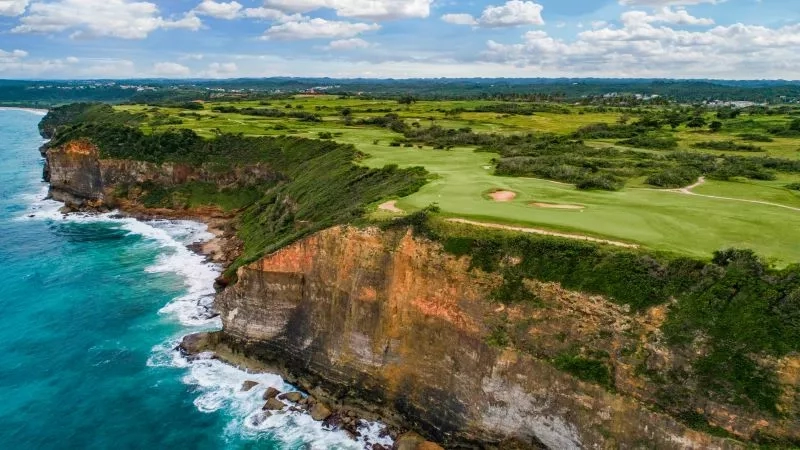When disaster hits, the easiest thing to do is freeze. But the best thing to do is rally the community, steady the ship, and keep people excited to visit, even when the future feels uncertain.
For destinations, resilience means survival. Fires, floods, economic downturns, you name it, have the power to turn everything upside down. But the destinations that bounce back fastest are the ones with strong communities, smart planning, and a clear story to tell.
According to the Digital Tourism Think Tank, once disaster hits, “the instinctive reaction is often to avoid these places … But what if we challenged this assumption? What if, instead of shying away, we saw these events as a chance to reimagine the role of tourism in disaster recovery?”
In this blog, we’ll dive into what every destination can do to turn tough times into a comeback story worth sharing. We’ll also share how destinations like Los Angeles and Puerto Rico handled the aftermath of disaster and rebuilt their economies.
Community rebuilding: resilience starts at home
When the going gets tough, the first place a destination needs to look is home. Tourism doesn’t survive without locals: the small businesses, event teams, hospitality workers, and proud residents who give a place its heart. If you don’t have their buy-in during tough times, it’s going to show. Big time.
“We’re grateful for our incredible Angeleno community, which understands that tourism is a vitally important support for our community as we come together to help our community. In moments like these, tourism does more than drive our economy – it becomes a lifeline in supporting our community’s recovery.”
– Adam Burke, President & CEO of Los Angeles Tourism.
From small business owners to hospitality workers, local leaders to everyday residents, LA rallied around one shared belief: that tourism is more than just travel. It’s personal. It’s local. And it impacts lives.
When travelers come to the city, whether for leisure or large-scale events, they’re helping fund public services, keep small businesses thriving, and preserve the cultural heartbeat of the region. During the wildfire crisis, this connection between tourism and community well-being was a lifeline.
“Much like the entertainment industry's critical role in LA’s economy, tourism is one of the most significant drivers of employment, local business sales, and tax dollars that provide essential services for all Angelenos, including public safety.
Traveling to Los Angeles right now directly supports the 540,000 Angelenos and 1,000 local businesses who depend on tourism for their livelihoods.”
This spirit of community-driven resilience is something every destination can take to heart. Rebuilding after disruption starts with investing in the people who make your destination unique, and keeping tourism dollars flowing.
5 ways to rally your community
Here are five ways to get your community back onto its feet during or following challenging times.
1. Make local businesses part of the story
Don’t just market the big attractions. Spotlight local shops, restaurants, hotels, and event spaces in your campaigns. Show visitors and locals that tourism success is a team effort.
2. Host “we’re open” events
After a crisis, organize neighborhood pop-ups, community fairs, or open houses that get people back out and spending. It's a low-pressure, high-impact way to build momentum and lift spirits.
3. Start a local heroes campaign
Celebrate the chefs, hotel workers, volunteers, and first responders who make your destination special. A simple social media shoutout or short video series goes a long way toward building pride and loyalty.
4. Give locals a reason to be tourists
Offer exclusive discounts or "locals-only" experiences. If residents fall back in love with their hometown, visitors will feel that energy too.
5. Keep communication real and two-way
Updates are great, but make listening a priority too. Host town halls, send community surveys, ask businesses and residents what they need and act on it. Trust is built through real conversations, not just polished press releases.
Meetings and events as recovery catalysts
When disaster hits, it’s tempting for destinations to focus only on vacationers. But meetings and events might just be your fastest ticket to recovery.
Business events don’t just fill hotel rooms. They send a clear message: We’re open, and we’re ready. Conferences, trade shows, and corporate meetings bring big groups who spend big money on hotels, dining, transport, and experiences. They also create momentum, giving locals and visitors alike a reason to get back out and about.
Puerto Rico
In September 2017, Puerto Rico was hit by Category 5 Hurricane Maria, which devastated the island. It was the tenth most intense Atlantic hurricane on record, with deaths almost reaching 3,000 just on Puerto Rico alone. Waist-deep water, roofless homes, and areas without power, cell, or water service plagued the island for months.
This hurricane led to the creation of Discover Puerto Rico, the island’s official tourism promoter.
“We began in 2018 with no pipeline of meetings and convention business. Jobs were not very available. Businesses were struggling,” said Brad Dean, CEO of Discover Puerto Rico.
The destination marketing organization went to work reengaging with event professionals, travel managers, and tourists to “put the transformative power of travel and meetings to work for the people of Puerto Rico,” according to Dean.
Los Angeles
LA is also a great example of the power of meetings and events.
“Meetings and events in Los Angeles in recent months have played a key role in our recovery. These groups committed to LA as their host city and actively contributed to wildfire relief efforts, underscoring their belief in our city's strength and future.
“For example, the Society of Thoracic Surgeons held its Annual Meeting here and launched the STS Los Angeles Wildfire Response Fund, raising more than $250,000 for local recovery through the Thoracic Surgery Foundation. Similarly, the Americas Lodging Investment Summit (ALIS) convened at the JW Marriott at L.A. LIVE, where Los Angeles Tourism joined forces with Northstar Travel Group, the American Hotel & Lodging Association, and LA Works to assemble 500 support kits for emergency responders. This unwavering commitment from our meetings and events community is a testament to LA’s enduring appeal and readiness to welcome the world.”
– Adam Burke
For destinations, the takeaway is simple: Don’t just hope events will stick around during tough times. Make them part of your recovery story. Highlight how groups can leave a positive impact, not just on the economy, but on the local community.
Also read: Los Angeles Corporate Event Planning Guide
That’s why tools that drive visibility and bookings (like the Cvent Supplier Network) are essential in times of recovery. By helping destinations stay connected to meeting planners worldwide, CSN ensures your hotels and venues remain top of mind when it’s time to book.
Keeping experiences accessible and inspirational
When times get tough, it’s crucial for destinations to keep their doors open, their experiences easy to access, and their messaging full of inspiration.
“We want to showcase all that you can do,” says Dean. “Enjoying [Puerto Rico’s] rich, vibrant culture will make a meeting really special and unique and have attendees talking before, during, and long after the event.”
But what about when experiences aren’t readily available to tourists, as was the case when COVID-19 struck? The Amsterdam Convention Bureau decided to update their marketing strategy once pandemic restrictions on travel and in-person events were lifted.
“We saw the reopening as a chance to start fresh. Our goal became to make Amsterdam a more attractive and in-demand destination for event organizers," says Bart Antonissen, Account Manager at Amsterdam Convention Bureau.
Paris's DMO similarly adapted its communication strategies on platforms like Instagram to maintain engagement with potential visitors. The DMO shared images and stories that highlighted the city's resilience and ongoing cultural vibrancy. And this helped keep Paris top-of-mind for future travelers.
For destinations everywhere, the playbook is clear:
Keep your best experiences front and center.
Make it easy for visitors to plan.
Show them why now is still a great time to come.
And don’t forget the bleisure crowd. Today’s business travelers want more than ballrooms and boardrooms. They’re looking to blend work trips with beach days, gallery hops, food tours, and hikes. By promoting the leisure side of your destination alongside meeting capabilities, you’ll capture that extra layer of spend and give travelers even more reason to choose you.
Quick tip: Having a polished, up-to-date profile on CSN helps meeting planners see not just your venues, but also the amazing experiences they can package in for their attendees. Easy sell.
Storytelling and strategic marketing: reinforcing the brand
When crises hit, your destination’s story matters more than ever. It’s about reminding the world who you are, what you stand for, and why you're worth the visit.
Los Angeles showed how it’s done with their “We Love LA” campaign.
“Los Angeles Tourism is actively promoting the city globally as a resilient and welcoming destination through its new “We Love LA” campaign – an anthemic and visually stunning tribute to the people and places that make our destination remarkable,” says Burke.
“Launched in March 2025, the campaign was designed as a love letter to Los Angeles and Angelenos, and is a celebration of LA’s diversity, creativity and strength, positing LA as a place that will always welcome the world and will continue to thrive in the face of challenges. The campaign is currently running across paid media platforms in domestic markets.”
In tough times, lean into what makes your destination uniquely yours. Don’t go quiet. Don’t play it safe. Tell stories that celebrate your people, your culture, your spirit and make sure those stories are getting in front of the right audiences.
And when it comes to the meetings and events world, market the experience. Meeting planners want to know: Can their attendees still have an incredible time? Will they feel inspired, welcomed, safe? This is where CSN comes in handy, giving destinations a powerful way to stay visible, tell their story, and make it easy for planners to choose them.
5 ways to market your destination in a downturn
A good story builds pride at home and confidence abroad. In challenging times, it’s one of the strongest tools a destination has. Here’s five ways to market your destination when the going gets tough:
Know your destination inside and out
Before you can sell your destination, you have to really know it. What makes it different? What experiences can't visitors get anywhere else? Get clear on your strengths, your hidden gems, and the stories that make your community shine. Prioritize the ones that feel reassuring and exciting during tougher times.
Take advantage of data
Guesswork won’t cut it when the market gets tricky. Dig into the data and look at who’s still traveling, what types of events are moving forward, what new trends are popping up. Demand reports and historical data can help identify these things. The right insights will help you focus your time, money, and messaging where it actually matters.
Discover the data to help CVBs drive more group business
Consider your target audience
Not every traveler or event planner is looking for the same thing and that's even more true during a downturn. Are you focusing on regional groups? Leisure travelers turning trips into "bleisure" experiences? International visitors who value culture and sustainability? Fine-tune your messages to the people most likely to choose you right now.
Team up with hotels
You’re stronger together. Collaborate with hotels, venues, and local businesses to create bundled deals, special promotions, and custom experiences. In tough times, giving planners a full, easy-to-book package, instead of just a venue, can make all the difference.
Focus on the entire funnel
It’s not enough to just get attention — you need to turn interest into action. Think about every step of the journey: awareness, consideration, booking, and post-visit loyalty. Use marketing, sales outreach, and loyalty strategies that keep your destination top of mind from start to finish.
Investing in infrastructure and futureproofing
It’s one thing to weather a storm. It’s another to come out stronger on the other side. The smartest destinations are building for the future.
Puerto Rico invested in infrastructure and talent to make the island stand out as a professional and polished destination — rather than just a place to relax on the beach. And once they started to advertise this on the Cvent Supplier Network, they saw a “huge surge in our lead volume.”
Nepalis another example. The 2015 Gorkha earthquake severely impacted Nepal's tourism sector. In response, Nepal's tourism authorities worked to rebuild infrastructure and heritage sites, while also promoting the country's readiness to welcome tourists again. Efforts included highlighting restored sites and emphasizing the role of tourism in the nation's recovery.
The message is clear: investment signals confidence. It shows visitors, locals, and planners that your destination is open for business and only getting better.
For CVBs and tourism boards, this means thinking big and smart. What new venues or upgrades will meet tomorrow’s traveler expectations? How can your city be easier to navigate, more sustainable, and even more welcoming to international guests?
And when you’ve made those investments, shout about them. Use tools like CSN to spotlight new spaces, highlight improvements, and keep your destination top of mind for planners looking for their next perfect host city.
Building stronger, smarter destinations
Resilience is about building a foundation that can handle whatever comes next. The most successful destinations know this. They rally their communities, lean into meetings and events, keep experiences exciting and accessible, tell powerful stories, and invest in the future.
DMOs and CVBs show us what's possible. From wildfires to hurricanes, its commitment to community, visitors, and brand that matters.
For CVBs and tourism boards, the answer is clear: stay connected, stay visible, and stay ready. Keep showing the world not just why they should visit, but why they should believe in you.
With the right strategies (and the right partners — like CSN to help keep your destination front and center), the future looks bright, no matter what challenges come your way.








